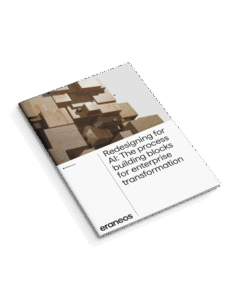In the race to implement AI, organizations face a stark reality – despite billions in investment, few have achieved real transformation. While 75% of companies rank Generative AI as a top priority, only 25% have derived significant economic benefits. This gap marks not just a missed opportunity, but an emerging strategic fault line as AI shifts from experimental innovation to competitive necessity.
The AI reality: Great expectations, sobering results
Behind these disappointing adoption statistics lies a fundamental misalignment in how organizations approach AI implementation. AI success depends 80% on people and only 20% on technology – yet most AI efforts focus primarily on the technological aspects, creating a fundamental disconnect between investment and results.
This explains why many companies are falling into the “micro-productivity trap” – a proliferation of proofs of concept and isolated use cases that deliver modest, localized efficiency gains but fail to scale. Tools get deployed. Demos impress. But outcomes never materialize.
Innovation is tech-driven, but change is people-driven – this insight summarizes what many organizations learn the hard way. The introduction of AI tools alone does not create transformation. Without accompanying changes in working methods, decision-making processes, and corporate culture, even the most advanced AI solutions fall far short of their potential.
“Innovation is tech-driven, but change is people-driven – this insight summarizes what many organizations learn the hard way.”
The business cost of failed AI adoption
The consequences of this disconnect extend far beyond wasted technology investments and directly impact competitive positioning. Failed adoption doesn’t just waste investment, it erodes competitiveness. Organizations that lag in AI integration lose speed, consistency, and talent appeal. Meanwhile, competitors embedding AI into core processes gain compounding advantages that become exponentially harder to close over time.
The risks multiply as shadow AI proliferates. Without proper enablement, frustrated employees experiment with unauthorized AI tools, creating significant data security risks and compliance vulnerabilities that can threaten the entire organization.
Most common pitfalls in AI adoption
Years of AI projects have revealed typical patterns that hinder the success of AI initiatives:
- Tools-first illusion: Rolling out AI tools creates visibility, but without ongoing, hands-on enablement in day-to-day workflows, real adoption and impact remain superficial.
- Ambiguity gap: Unclear responsibilities and expectations leave employees uncertain. Organizations need to set concrete targets, transparent policies, and communicate available support to ensure confidence and direction.
- Training without development: Standalone trainings increase knowledge but rarely result in habit or behavioral change. Successful organizations focus on role-specific, regular coaching to embed sustainable AI practices.
Three key levers for successful AI transformation
From our experience most successful transformations share a common characteristic: they prioritize people over technology. While AI tools themselves are increasingly accessible and powerful, the human element remains the decisive factor in transformation success. Organizations that recognize this fundamental truth implement three interconnected levers that systematically address the psychological, cultural, and practical barriers to AI adoption.
1. From access to agency – Building the foundation
The first critical lever in unlocking AI’s potential is moving from mere access to true agency – while providing tools creates visibility, transformational value only emerges when employees develop the confidence, capability, and autonomy to apply AI effectively, responsibly, and independently in their daily work. Organizations that focus exclusively on tool deployment often see initial excitement followed by declining usage and minimal business impact. The missing element is agency – employees’ ability to identify opportunities, apply AI appropriately, and integrate it into workflows without constant expert support.
2. AI ambassadors – Driving peer-to-peer adoption
Selecting 1–2% of employees as AI Ambassadors builds peer-to-peer influence and cultural momentum. Equipped with time, resources, and recognition, they become catalysts for bottom-up adoption. When properly executed, this approach creates a self-reinforcing cycle where enthusiasm and expertise spread naturally through existing trust networks. Their informal credibility often drives deeper engagement than formal training ever could, dramatically reducing resistance while increasing both the speed and quality of AI integration across the enterprise.
3. AI coaching – The catalyst for sustainable skill development
While ambassador networks create momentum and peer support, organizations often need more structured guidance to systematically develop AI capabilities across diverse roles and functions. This is where dedicated coaching becomes essential – bridging the gap between tool access and true proficiency. Effective AI coaches, whether developed internally or engaged as external partners, bring critical advantages that complement AI Ambassador efforts. This is particularly true during the critical early phases when patterns of use are being established and employees are forming their understanding of AI’s potential.
The business case for AI coaching
The business case for investing in a people-centered AI transformation approach is compelling. Organizations that implement these strategies see accelerated time-to-value, with structured human enablement approaches achieving meaningful adoption 2-3 times faster than those relying on self-directed learning. This translates directly to faster realization of efficiency gains, cost savings, and competitive advantages.
Additionally, the most valuable AI use cases often come from employees who deeply understand their domain challenges. When properly enabled, these domain experts consistently identify more valuable and implementable opportunities than centralized AI teams working in isolation, creating a distributed innovation engine that continuously improves organizational performance.
Perhaps most importantly, successful AI adoption creates a cultural transformation that extends far beyond the technology itself. As employees gain confidence, they identify new opportunities, refine processes, and build increasingly sophisticated applications – creating an adaptive capability that responds to evolving business needs and positions the organization for ongoing innovation.
The path forward
As AI evolves from text to multimodal, from passive to physical, from tool to autonomous agent, the strategic importance of effective adoption only increases. The technology is increasingly accessible to all – the differentiator is how effectively organizations enable their people to harness it.
The next competitive frontier is not who has access to AI, but who has mastered the human side of transformation. Organizations that empower their people to innovate with AI will shape industries; those that delay will struggle to stay relevant.






